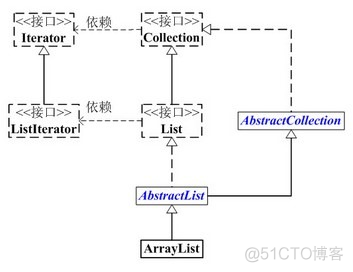Java ArrayList 源码
ArrayList 概述
ArrayList 是基于数组实现,是一个动态数组,容量可以自动增长,动态增加内存。
ArrayList 不是线程安全的,只能用在单线程,多线程换成环境下可以考虑 Collections.synchronizedList(List l) 函数返回一个线程安全的 ArrayList 类,也可以在 concurrent 并发包下的 CopyOnWriteArrayList 类。
ArrayList 实现了Serializable 接口,支持序列化传输,实现了 RandomAccess 即可,支持快速随机访问,实际上就是通过下标序号进行快速访问,实现 Cloneabale接口,可以被克隆。
每个 ArrayList 实例都有一个容量,该容量是指用例存储列表元素的数组大小,总是至少等于列表的大小,随着向ArrayList 不断添加元素,其容量会自动增长会带来数据向新数组的重新拷贝。
Collection 是 List,Set,Queue 的基础接口

ArrayList 属性
- 私有属性
ArrayList 定义只定义类有私有属性
private static final long serialVersionUID = 8683452581122892189L; // 使用serialVersionUID验证版本一致性private static final int DEFAULT_CAPACITY = 10; // 容量的初始大小
private static final Object[] EMPTY_ELEMENTDATA = {}; // Shared empty array instance used for empty instances.
private static final Object[] DEFAULTCAPACITY_EMPTY_ELEMENTDATA = {}; // Shared empty array instance used for default sized empty instances.
// ArrayList数据的存储之地
transient Object[] elementData; // 存储ArrayList中元素的数组
// ArrayList存储数据的个数
private int size;
elementData 存储 ArrayList 内的元素, size 标识它包含的元素的数量。
transient 的属性在对象呗序列化后不会被保存。
ArrayList 提供了三种方式的构造器,可以构造一个默认初始化为 10 的空列表,构造一个指定初始化容量的空列表与构造一个包含指定的 Collection 元素列表,这些按照 Collection 的迭代器返回他们的顺序排列。
public ArrayList(int initialCapacity) {if (initialCapacity > 0) {
this.elementData = new Object[initialCapacity];
} else if (initialCapacity == 0) {
this.elementData = EMPTY_ELEMENTDATA;
} else {
throw new IllegalArgumentException("Illegal Capacity: "+
initialCapacity);
}
}
通过传入 initialCapacity 的大小构造 ArrayList
使用初始容量构造 ArrayList
public ArrayList() {this.elementData = DEFAULTCAPACITY_EMPTY_ELEMENTDATA;
}
使用传入指定集合构造 ArrayList
public ArrayList(Collection extends E> c) {elementData = c.toArray();
if ((size = elementData.length) != 0) {
// c.toArray might (incorrectly) not return Object[] (see 6260652)
if (elementData.getClass() != Object[].class)
elementData = Arrays.copyOf(elementData, size, Object[].class);
} else {
// replace with empty array.
this.elementData = EMPTY_ELEMENTDATA;
}
}
方法
主要方法是增加,或者删除,修改,查找方法。
增加元素操作
public boolean add(E e){
// 1、确保容量大小
ensureCapacityInternal(size + 1); // Increments modCount!!
// 2、尾部添加元素
elementData[size++] = e;
return true;
}
指定位置添加元素
public void add(int index, E element){
// 1、检验索引
rangeCheckForAdd(index);
// 2、确保容量
ensureCapacityInternal(size + 1); // Increments modCount!!
// 3、将数据后移
System.arraycopy(elementData, index, elementData, index + 1,
size - index);
// 4、添加元素
elementData[index] = element;
// 5、数组元素个数加1
size++;
}
在尾部添加某类集合的所有元素
public boolean addAll(Collection extends E> c){
// 1、暂存集合c中数据
Object[] a = c.toArray();
int numNew = a.length;
// 2、确保容量
ensureCapacityInternal(size + numNew); // Increments modCount
// 3、尾部添加数据
System.arraycopy(a, 0, elementData, size, numNew);
// 4、数组元素个数更新
size += numNew;
return numNew != 0;
}
指定位置添加某类集合所有元素
public boolean addAll(int index, Collection extends E> c){
// 1、检验索引
rangeCheckForAdd(index);
// 2、暂存数据
Object[] a = c.toArray();
int numNew = a.length;
// 3、确保容量
ensureCapacityInternal(size + numNew); // Increments modCount
int numMoved = size - index;
// 4、数据后移
if (numMoved > 0)
System.arraycopy(elementData, index, elementData, index + numNew,
numMoved);
// 5、添加元素
System.arraycopy(a, 0, elementData, index, numNew);
// 6、数组元素个数更新
size += numNew;
return numNew != 0;
}
删除元素操作
删除 ArrayList 第一个符合条件的元素
public boolean remove(Object o){
// 移除值为null的元素
if (o == null)
{
for (int index = 0; index < size; index++)
if (elementData[index] == null)
{
fastRemove(index);
return true;
}
}
else // 移除元素
{
for (int index = 0; index < size; index++)
if (o.equals(elementData[index]))
{
fastRemove(index);
return true;
}
}
// 值不存在时,移除失败
return false;
}
其中 fastRemove 方法是采用的数组copy 方法。
private void fastRemove(int index){
// 1、修改的次数更新
modCount++;
int numMoved = size - index - 1;
// 2、数据前移
if (numMoved > 0)
System.arraycopy(elementData, index + 1, elementData, index,
numMoved);
elementData[--size] = null; // clear to let GC do its work
}
删除 ArrayList 中指定位置上的元素
public E remove(int index){
// 1、检验索引
rangeCheck(index);
modCount++;
E oldValue = elementData(index);
int numMoved = size - index - 1;
// 2、数据前移
if (numMoved > 0)
System.arraycopy(elementData, index + 1, elementData, index,
numMoved);
elementData[--size] = null; // clear to let GC do its work
return oldValue;
}
删除 ArrayList 中所包含集合中所有元素
public boolean removeAll(Collection> c){
Objects.requireNonNull(c);
return batchRemove(c, false);
}
删除某个范围的数据
是直接置空的
protected void removeRange(int fromIndex, int toIndex){
modCount++;
int numMoved = size - toIndex;
System.arraycopy(elementData, toIndex, elementData, fromIndex, numMoved);
// clear to let GC do its work
int newSize = size - (toIndex - fromIndex);
for (int i = newSize; i < size; i++)
{
elementData[i] = null;
}
size = newSize;
}
删除 ArrayList 中不是所传入集合的所有数据
public boolean retainAll(Collection> c){
Objects.requireNonNull(c);
return batchRemove(c, true);
}
修改操作
修改指定位置上的元素
public E set(int index, E element){
rangeCheck(index);
E oldValue = elementData(index);
elementData[index] = element;
return oldValue;
}
查找操作
获取指定位置上的元素
public E get(int index) {rangeCheck(index);
checkForComodification();
return ArrayList.this.elementData(offset + index);
}
获取指定元素在列表的第一个位置索引
public int indexOf(Object o){
if (o == null)
{
for (int i = 0; i < size; i++)
if (elementData[i] == null)
return i;
} else
{
for (int i = 0; i < size; i++)
if (o.equals(elementData[i]))
return i;
}
return -1;
}
获取指定元素在列表中的最后一个位置索引
public int lastIndexOf(Object o) {if (o == null) {
for (int i = size-1; i >= 0; i--)
if (elementData[i]==null)
return i;
} else {
for (int i = size-1; i >= 0; i--)
if (o.equals(elementData[i]))
return i;
}
return -1;
}
返回某个范围的视图
public List<E> subList(int fromIndex, int toIndex){
subListRangeCheck(fromIndex, toIndex, size);
return new SubList(this, 0, fromIndex, toIndex);
}
迭代器
public Iterator<E> iterator() {return new Itr();
}
private class Itr implements Iterator<E> {
int cursor; // index of next element to return
int lastRet = -1; // index of last element returned; -1 if no such
int expectedModCount = modCount;
public boolean hasNext() {
return cursor != size;
}
@SuppressWarnings("unchecked")
public E next() {
checkForComodification();
int i = cursor;
if (i >= size)
throw new NoSuchElementException();
Object[] elementData = ArrayList.this.elementData;
if (i >= elementData.length)
throw new ConcurrentModificationException();
cursor = i + 1;
return (E) elementData[lastRet = i];
}
public void remove() {
if (lastRet < 0)
throw new IllegalStateException();
checkForComodification();
try {
ArrayList.this.remove(lastRet);
cursor = lastRet;
lastRet = -1;
expectedModCount = modCount;
} catch (IndexOutOfBoundsException ex) {
throw new ConcurrentModificationException();
}
}
@Override
@SuppressWarnings("unchecked")
public void forEachRemaining(Consumer super E> consumer) {
Objects.requireNonNull(consumer);
final int size = ArrayList.this.size;
int i = cursor;
if (i >= size) {
return;
}
final Object[] elementData = ArrayList.this.elementData;
if (i >= elementData.length) {
throw new ConcurrentModificationException();
}
while (i != size && modCount == expectedModCount) {
consumer.accept((E) elementData[i++]);
}
// update once at end of iteration to reduce heap write traffic
cursor = i;
lastRet = i - 1;
checkForComodification();
}
final void checkForComodification() {
if (modCount != expectedModCount)
throw new ConcurrentModificationException();
}
}
listIterator 方法
public ListIterator<E> listIterator(int index) {if (index < 0 || index > size)
throw new IndexOutOfBoundsException("Index: "+index);
return new ListItr(index);
}
状态操作
是否为空
public boolean isEmpty(){
return size == 0;
}
清空列表元素
public void clear(){
modCount++;
// clear to let GC do its work
for (int i = 0; i < size; i++)
elementData[i] = null;
size = 0;
}
克隆 ArrayList 实例副本
public Object clone(){
try
{
ArrayList> v = (ArrayList<?>) super.clone();
v.elementData = Arrays.copyOf(elementData, size);
v.modCount = 0;
return v;
} catch (CloneNotSupportedException e)
{
// this shouldn't happen, since we are Cloneable
throw new InternalError(e);
}
}
判断是否包含某个指定元素
public boolean contains(Object o){
return indexOf(o) >= 0;
}
获取元素个数
public int size(){
return size;
}
转换成数组
public Object[] toArray(){
return Arrays.copyOf(elementData, size);
}
转换
public <T> T[] toArray(T[] a){
if (a.length < size)
// Make a new array of a's runtime type, but my contents:
return (T[]) Arrays.copyOf(elementData, size, a.getClass());
System.arraycopy(elementData, 0, a, 0, size);
if (a.length > size)
a[size] = null;
return a;
}
还有几个问题等解决
- fail-fast 机制
- 序列化问题
- 遍历效率问题
参考资料
欢迎关注公众号:程序员开发者社区

关注我们,了解更多
